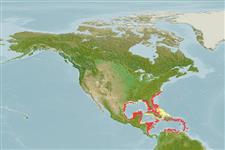>
Gobiiformes (Gobies) >
Gobiidae (Gobies) > Gobiinae
Etymology: Microgobius: Greek, mikros = small + Latin, gobius = gudgeon (Ref. 45335).
More on author: Fowler.
Environment: milieu / climate zone / depth range / distribution range
Écologie
marin récifal; profondeur 0 - 36 m (Ref. 92840). Subtropical; 37°N - 10°N
Western Atlantic: North Carolina, USA and eastern Gulf of Mexico to the Lesser Antilles.
Taille / Poids / Âge
Maturity: Lm ? range ? - ? cm
Max length : 10.0 cm SL mâle / non sexé; (Ref. 92840)
Distinguished by the following characteristics: general body color is light grey-brown, typically have areas of very bright iridescent blue and/or yellow; body is laterally compressed; large, nearly vertical mouth; completely scaled body; first dorsal with VII spines; ventral fins are united (Ref. 92840).
Burrows in bottom in open stretches of coarse sand. Often hovers over burrow. Also known to inhabit mangrove streams with very fine silt-mud substrate (Ref. 92840).
Life cycle and mating behavior
Maturité | Reproduction | Frai | Œufs | Fécondité | Larves
Robins, C.R. and G.C. Ray, 1986. A field guide to Atlantic coast fishes of North America. Houghton Mifflin Company, Boston, U.S.A. 354 p. (Ref. 7251)
Statut dans la liste rouge de l'IUCN (Ref. 130435)
Menace pour l'homme
Harmless
Utilisations par l'homme
Aquarium: Commercial
Plus d'informations
RéférencesAquacultureProfil d'aquacultureSouchesGénétiqueElectrophoresesHéritabilitéPathologiesTraitementNutrientsMass conversion
Outils
Articles particuliers
Télécharger en XML
Sources Internet
Estimates based on models
Preferred temperature (Ref.
123201): 23.7 - 28.1, mean 27.2 °C (based on 445 cells).
Phylogenetic diversity index (Ref.
82804): PD
50 = 0.5000 [Uniqueness, from 0.5 = low to 2.0 = high].
Bayesian length-weight: a=0.00708 (0.00333 - 0.01504), b=3.09 (2.92 - 3.26), in cm total length, based on LWR estimates for this (Sub)family-body shape (Ref.
93245).
Niveau trophique (Ref.
69278): 3.4 ±0.4 se; based on size and trophs of closest relatives
Résilience (Ref.
120179): Haut, temps minimum de doublement de population inférieur à 15 mois (Preliminary K or Fecundity.).
Fishing Vulnerability (Ref.
59153): Low vulnerability (10 of 100).
Nutrients (Ref.
124155): Calcium = 83.6 [33.3, 182.1] mg/100g; Iron = 0.747 [0.330, 1.528] mg/100g; Protein = 18.6 [16.6, 20.4] %; Omega3 = 0.144 [0.058, 0.300] g/100g; Selenium = 11.9 [4.8, 29.9] μg/100g; VitaminA = 80.7 [18.5, 321.2] μg/100g; Zinc = 1.33 [0.78, 2.22] mg/100g (wet weight);
